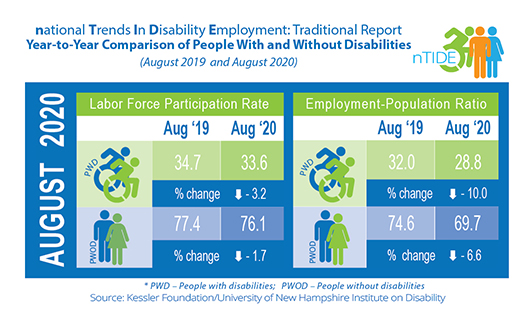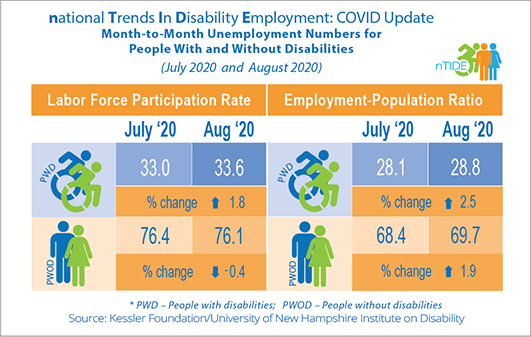nTIDE August 2020 Jobs Report: Modest Gains Encouraging for Americans with Disabilities


Kessler Foundation and University of New Hampshire nTIDE Report—featuring The Chicagoland Entrepreneurship Education for People with Disabilities (CEED) Project, an evidence-based, comprehensive entrepreneurship education and training program for people with disabilities and service providers in Illinois
East Hanover, NJ – September 4, 2020 – August job numbers show improvement for Americans with disabilities, according to today’s National Trends in Disability Employment – Monthly Update (nTIDE), issued by Kessler Foundation and the University of New Hampshire’s Institute on Disability (UNH-IOD). Experts express caution due to the many factors that could affect economic recovery.
nTIDE COVID Update (month-to-month comparison)
In the Bureau of Labor Statistics (BLS) Jobs Report released Friday, the employment-to-population ratio for working-age people with disabilities increased from 28.1 percent in July to 28.8 percent in August 2020 (up 2.5 percent or 0.7 percentage points). For working-age people without disabilities, the employment-to-population ratio also increased from 68.4 percent in July to 69.7 percent in August 2020 (up 1.9 percent or 1.3 percentage points). The employment-to-population ratio, a key indicator, reflects the percentage of people who are working relative to the total population (the number of people working divided by the number of people in the total population multiplied by 100).
Comparing month-to-month numbers (July 2020 to August 2020), “We see modest improvements in the employment-to-population ratio for people with and without disabilities, reflecting a recovery of economic activity,” said John O’Neill, PhD, director of employment and disability research at Kessler Foundation. “This is particularly encouraging for people with disabilities, who experienced a slight downturn last month,” he added.
The labor force participation rate for working-age people with disabilities increased from 33 percent in July to 33.6 percent in August 2020 (up 1.8 percent or 0.6 percentage points). For working-age people without disabilities, the labor force participation rate also decreased from 76.4 percent in July to 76.1 percent in August 2020 (down 0.4 percent or 0.3 percentage points). The labor force participation rate is the percentage of the population that is working, not working and on temporary layoff, or not working and actively looking for work.
“The modest increase in the labor force participation rate is also a good sign, compared to the decrease we saw last month,” said economist Andrew Houtenville, PhD, professor of economics and research director of the University of New Hampshire’s Institute on Disability. “It suggests that workers are staying engaged in the labor force, meaning they are employed, on temporary layoff, or actively looking for work. While the numbers are positive, caution is warranted,” he added. “There are many factors that could affect recovery over the next few months, including the possibility of a second wave of COVID-19.”
nTIDE August COVID Update – Friday, September 18 at 12:00 pm Eastern
Stay tuned for more about the employment of people with disabilities as we follow the impact of COVID-19 and look at the numbers in more detail.
Traditional nTIDE Numbers (comparison to the same time last year)
The employment-to-population ratio for working-age people with disabilities decreased from 32 percent in August 2019 to 28.8 percent in August 2020 (down 10 percent or 3.2 percentage points). For working-age people without disabilities, the employment-to-population ratio also decreased from 74.6 percent in August 2019 to 69.7 percent in August 2020 (down 6.6 percent or 4.9 percentage points).
The labor force participation rate for working-age people with disabilities decreased from 34.7 percent in August 2019 to 33.6 percent in August 2020 (down 3.2 percent or 1.1 percentage points). For working-age people without disabilities, the labor force participation rate also decreased from 77.4 percent in August 2019 to 76.1 percent in August 2020 (down 1.7 percent or 1.3 percentage points).
For reference, in August 2020, among workers ages 16-64, the 4,178,000 workers with disabilities represented 3 percent of the total 137,553,000 workers in the U.S.
Beyond the Numbers
As the nation continues to grapple with the effects of the ongoing pandemic, intense pressures are transforming every aspect of society, including education, government, health care, business, and employment. For all Americans, the world of work is changing rapidly, requiring workers to consider all the options for staying in the labor force. Starting one’s own business is an option that gains traction during periods of recession, according to Kate Caldwell, PhD, clinical assistant professor in the Department of Disability & Human Development at the University of Illinois at Chicago.
Innovation is a necessity for people with disabilities, who are accustomed to finding ways to overcome challenges in daily life. Self-employment and entrepreneurship offer a pathway for individuals to apply their ingenuity in the workforce and strive for financial self-sufficiency on their own terms. The impact of self-employment and entrepreneurship extend beyond the direct economic benefits for individuals with disabilities. Creating new businesses often means providing new products and services and developing solutions to challenges faced by people with and without disabilities.
Policies and programs that support disability-owned businesses are critical to maximizing the potential for job growth in this area. When entrepreneurs with disabilities succeed, they create jobs for people with disabilities. Dr. Caldwell serves on the project team for The Chicagoland Entrepreneurship Education for People with Disabilities (CEED) Project, which offers an evidence-based, comprehensive entrepreneurship education and training program for people with disabilities and service providers working in disability community agencies and small business development centers in Illinois. Using a person-centered approach, the program targets the specific needs and barriers experienced by people with disabilities looking to start or grow a business.
The CEED Project projects the potential for entrepreneurship to create U.S. jobs. Based on data showing 10% self-employment among workers with disabilities, there are an estimated 850,000 entrepreneurs. If 65% of their businesses survived, and they were able to hire one person, more than 550,000 jobs would be created for people with disabilities. Sustainable businesses would continue to add workers each year, and build capacity to fuel community development and support social missions, helping address the poverty that underlies social inequities.
Given the evolving economic conditions, programs such as The CEED Project are critical to keeping options open for workers with disabilities. “There are many uncertainties about the future of work,” notes Dr. Caldwell, “Acquiring the skills to start and grow a business is an important way for people with disabilities to prepare for that future.”
Ask Questions about Disability and Employment
Join our nTIDE Lunch & Learn series today, September 4, at 12:00 pm Eastern. This live broadcast, hosted via Zoom Webinar, offers attendees Q&A on the latest nTIDE findings, provides news and updates from the field, as well as invited panelists to discuss current disability-related findings and events. For this episode, Kate Caldwell, PhD, Department of Disability & Human Development at the University of Illinois at Chicago joins Dr. Houtenville, Dr. O’Neill, and Denise Rozell, Policy Strategist at AUCD. Join live or watch the recordings at: ResearchonDisability.org/nTIDE.
NOTE: The statistics in the nTIDE are based on Bureau of Labor Statistics numbers but are not identical. They are customized by UNH to combine the statistics for men and women of working age (16 to 64). nTIDE is funded, in part, by grants from the National Institute on Disability, Independent Living and Rehabilitation Research (NIDILRR) (90RT5037) and Kessler Foundation.
About Kessler Foundation
Kessler Foundation, a major nonprofit organization in the field of disability, is a global leader in rehabilitation research that seeks to improve cognition, mobility, and long-term outcomes -- including employment -- for people with neurological disabilities caused by diseases and injuries of the brain and spinal cord. Kessler Foundation leads the nation in funding innovative programs that expand opportunities for employment for people with disabilities. For more information, visit KesslerFoundation.org.
About the Institute on Disability at the University of New Hampshire
The Institute on Disability (IOD) at the University of New Hampshire (UNH) was established in 1987 to provide a coherent university-based focus for the improvement of knowledge, policies, and practices related to the lives of persons with disabilities and their families. For information on the NIDILRR-funded Employment Policy and Measurement Rehabilitation Research and Training Center, visit ResearchonDisability.org.
For more information, or to interview an expert, contact:
Carolann Murphy, 973.324.8382, [email protected].